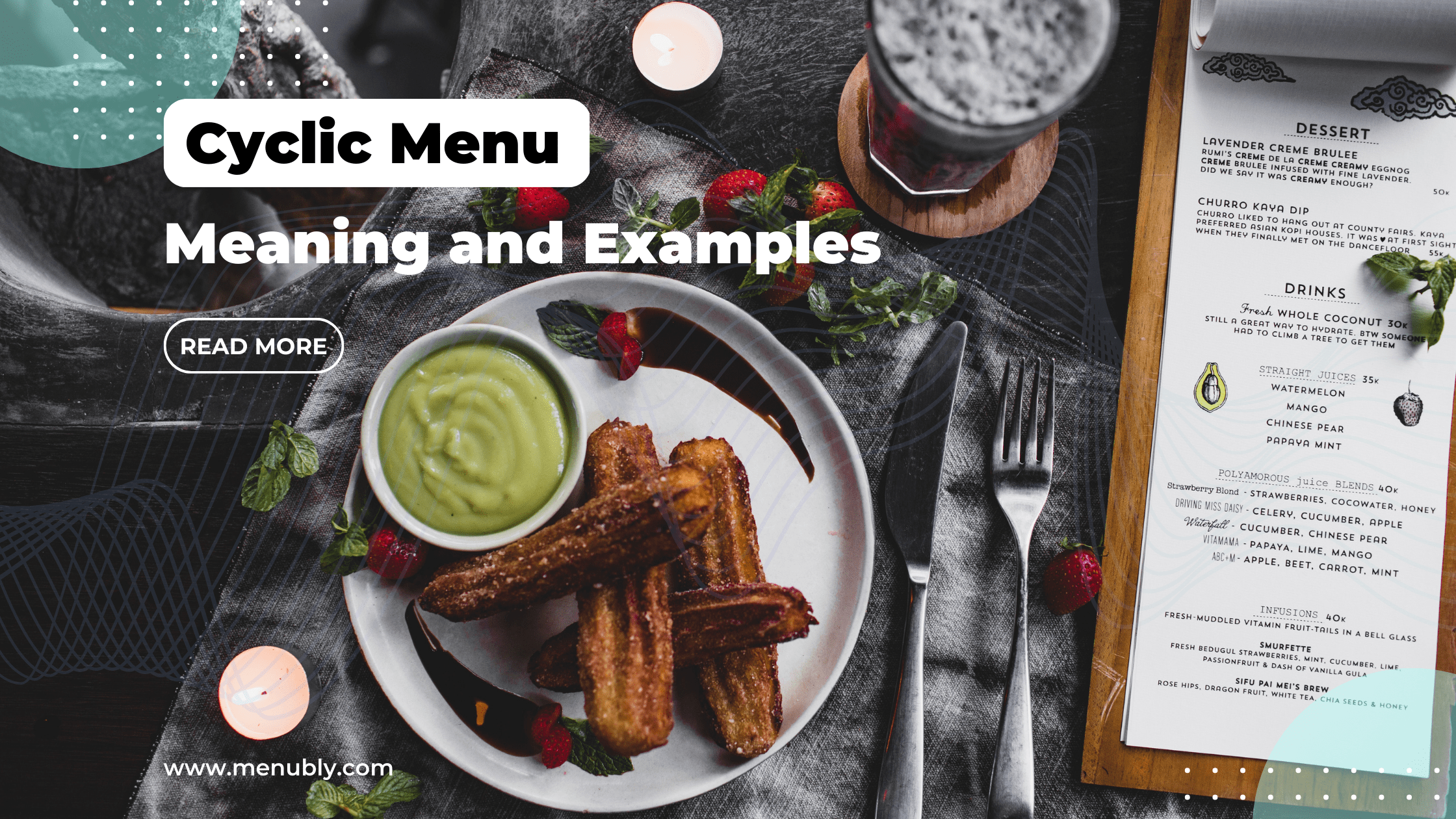
In today’s world, where food waste, nutrition, and cost-effectiveness are crucial concerns, cycle menus have emerged as a popular solution. Whether you run a school cafeteria, hospital kitchen, or restaurant, using a cycle menu can help you optimize your food service operations while also benefiting your customers. A cycle menu is a pre-designed menu that is repeated over a specific period, usually four to six weeks, before changing to a new menu cycle.
The cycle menu concept ensures that meals are served on a rotation basis, which reduces food waste by allowing the efficient use of ingredients. Furthermore, cycle menus can help control costs by allowing for better inventory management and efficient use of staff resources. Moreover, it offers a wide variety of dishes that can be enjoyed by customers, promoting better nutrition and portion control.
In this blog, we will dive deeper into the concept of a cycle menu, its benefits, and how to design and implement it successfully. Let’s explore how this innovative restaurant menu concept can transform your food service operations and benefit your customers.
A cycle menu is a pre-planned set of menus that is repeated in a specific order for a certain period, such as a week or a month. Unlike other types of menu that change frequently; with cycle menus, each day’s meal offerings are predetermined. This allows for the planning of meals in advance, ensuring that food items are used efficiently, and ingredients are not wasted. Cycle menu is a useful product for institutions such as schools, hospitals, as well as restaurants, that seek to streamline their meal planning process.
The cycle concept is based on the principle of menu rotation. The menu rotation allows for meals to be served in a pre-determined sequence, ensuring that meals are varied, and all food groups are included. The length of the cycle is determined by the number of different meals planned, which can vary depending on the setting and the nutritional requirements of the intended consumers. The cycle can range from one week to a month or even longer.
The cycle menu provides a framework for planning nutritious meals that meet the dietary needs of the intended consumers. The menu takes into consideration factors such as food preferences, allergies, and cultural requirements. For instance, in schools, the cycle menu will consider the nutritional needs of children at different ages and the time available for lunch breaks. Similarly, in hospitals, the cycle menu will take into consideration the dietary needs of patients based on their medical conditions.
Cycle menus can be useful in a variety of settings where meals are served regularly to customers, such as:
Schools: Cycle menus are commonly used in schools to ensure that students are provided with a balanced and nutritious diet that meets their daily requirements. With cycle menus, schools can plan menus for several weeks in advance, ensuring that students are served a variety of meals that cater to different dietary requirements.
Hospitals and healthcare facilities: Hospitals and healthcare facilities often have patients with unique dietary requirements and restrictions. Cycle menus can help ensure that these patients are provided with healthy and balanced meals that cater to their individual needs.
Restaurants and cafes: Cycle menus can help restaurants and cafes manage their inventory, reduce food waste, and streamline their operations. By planning menus in advance, they can optimize their kitchen resources, reduce preparation time, and offer customers a variety of dishes that cater to their preferences.
Senior living communities: Senior living communities may have residents with dietary restrictions or health concerns that require specific meal planning. Cycle menus can help ensure that these residents are served with nutritious and well-balanced meals that cater to their dietary needs.
Corporate and institutional dining: Cycle menus can also be useful in corporate and institutional dining settings, where employees or members are served with meals regularly. By planning menus in advance, these settings can optimize their resources, reduce costs, and provide their members with a variety of meal options.https://www.menubly.com/blog/what-is-a-restaurant-menu/
Turn your paper menu into an interactive online menu that customers can access anywhere. Plus, take pick-up & delivery orders directly and keep 100% of your sales - no commission fees.
Advantages of a Cycle Menu
Using a cycle menu offers several advantages for food service operations in different settings such as schools, hospitals, and restaurants. Here are some key benefits of using a cycle menu:
Efficiency: Cycle menus have been found to be an efficient solution for using ingredients and resources. By pre-planning the menu, you can optimize your inventory management and reduce food waste. Also, the kitchen staff can prepare meals faster as they can follow the same recipes repeatedly over the cycle period, leading to more efficient operations.
Reduced Food Waste: By using a cycle menu, the menu items can be planned in advance, ensuring efficient use of ingredients and reducing food waste. Since the menu items are repeated over a specific period, it allows for better inventory management, and the kitchen staff can plan the quantities of ingredients needed more accurately.
Cost-effectiveness: A cycle menu can help control costs by allowing for better inventory management and efficient use of staff resources. With a cycle menu, the kitchen staff can plan the quantities of ingredients needed, reducing the risk of over-ordering and waste. Furthermore, since the menu items are pre-designed, it allows for better control over food costs and can help optimize the use of resources such as time and energy.
Better Nutrition and Portion Control: By planning the menu items in advance, a cycle menu can ensure that customers receive the required nutrients and portions for each meal. The menu can be customized to cater to different dietary requirements and restrictions, ensuring that all customers receive a meal that meets their nutritional needs.
Efficient use of Kitchen Resources and Staff: Similar to table d’hote menu, a cycle menu allows for the efficient use of kitchen resources and staff. By planning the menu items in advance, it allows the kitchen staff to plan their work and tasks more efficiently, ensuring that they can meet the demand for meals. It also ensures that kitchen staff can prepare the required ingredients in advance, reducing the time needed to prepare each meal.
While using a cycle menu can offer several advantages for food service operations, there are also some potential disadvantages to consider. Here are some key disadvantages of using a cycle menu:
Lack of flavor variety: Although a cycle menu provides a wide variety of meals, some customers may feel that the repeated menu items can become monotonous over time. This can lead to dissatisfaction with the taste and flavor of the meals.
Limited Flexibility: in contrast to an A La Carte menu which provide customers with a variety of dishes to choose from, a cycle menu is pre-designed and repeated over a specific period, which can limit the ability to adapt to changes in customer demand, ingredient availability, or seasonal variations. This can be challenging for food service operations that require more flexibility in their menus.
Menu Planning Complexity: Developing and implementing a cycle menu can be complex, requiring careful planning, organization, and coordination. It can be challenging to design a menu that meets the nutritional needs of customers, caters to different dietary requirements and restrictions, and provides a balanced and varied diet over the course of the cycle.
Staff Training and Coordination: Implementing a cycle menu requires coordination and training of kitchen staff to ensure that they are familiar with the menu items, can prepare them efficiently, and maintain consistency in the quality of meals.
Increased Initial Costs: Developing a cycle menu requires an initial investment in planning, recipe development, and training. This can result in increased costs at the outset, which may be challenging for some food service operations.
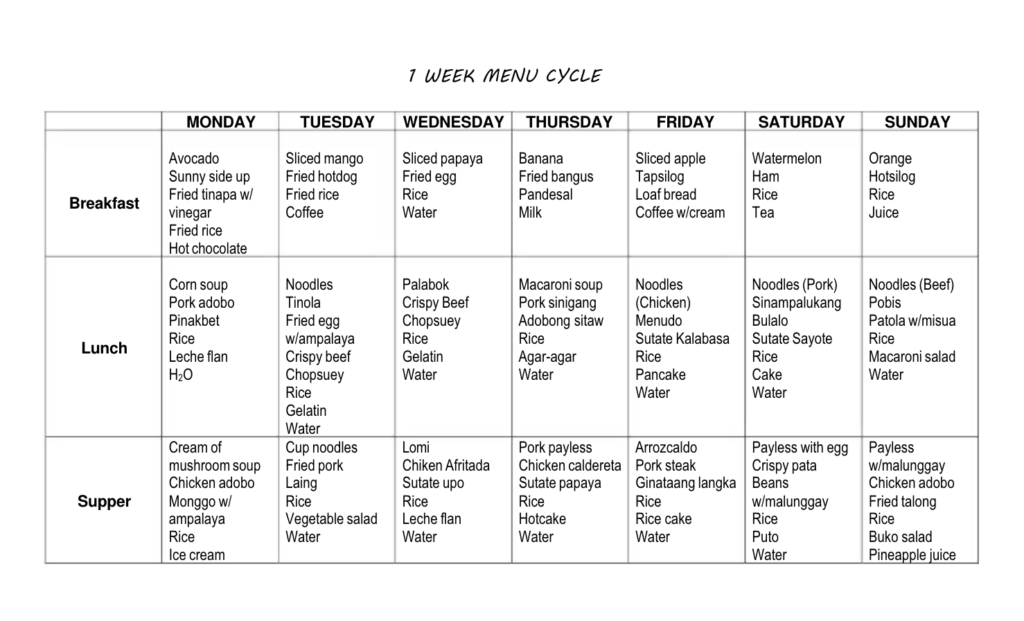
Example of Cycle Menu for 1 month
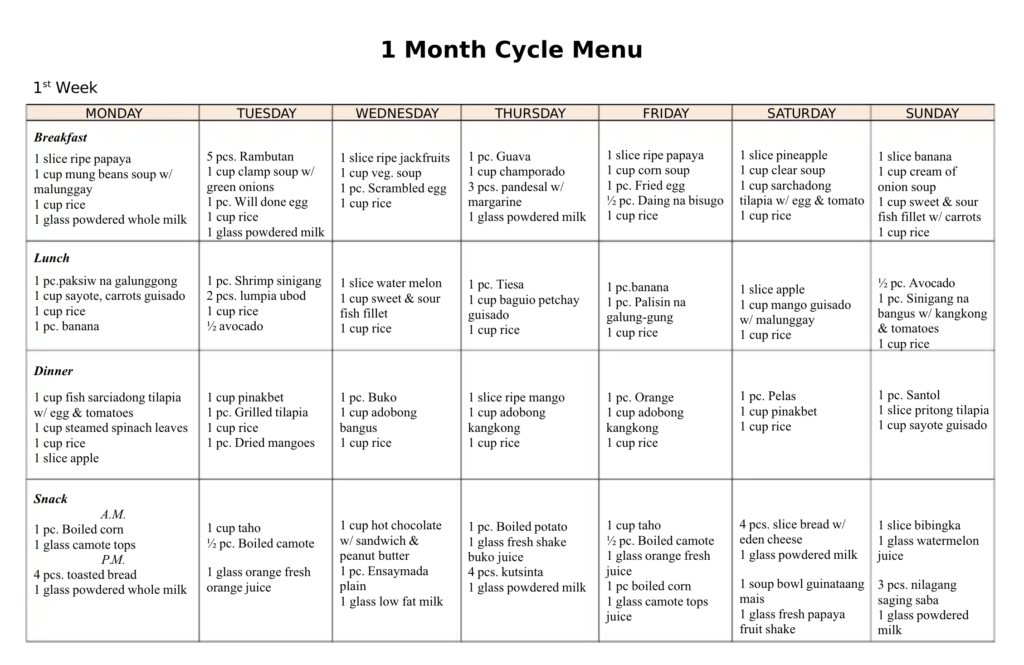
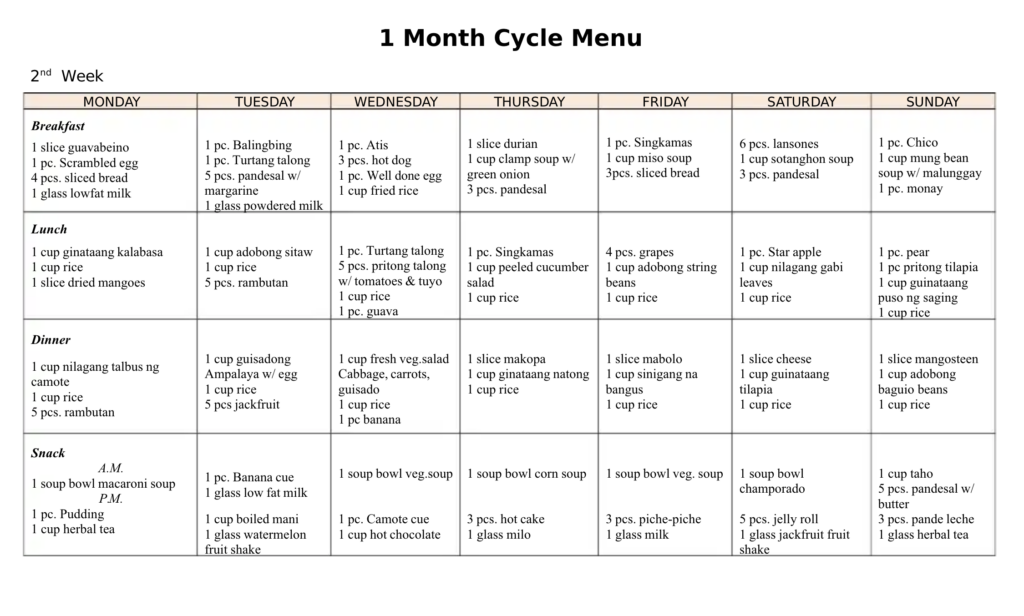
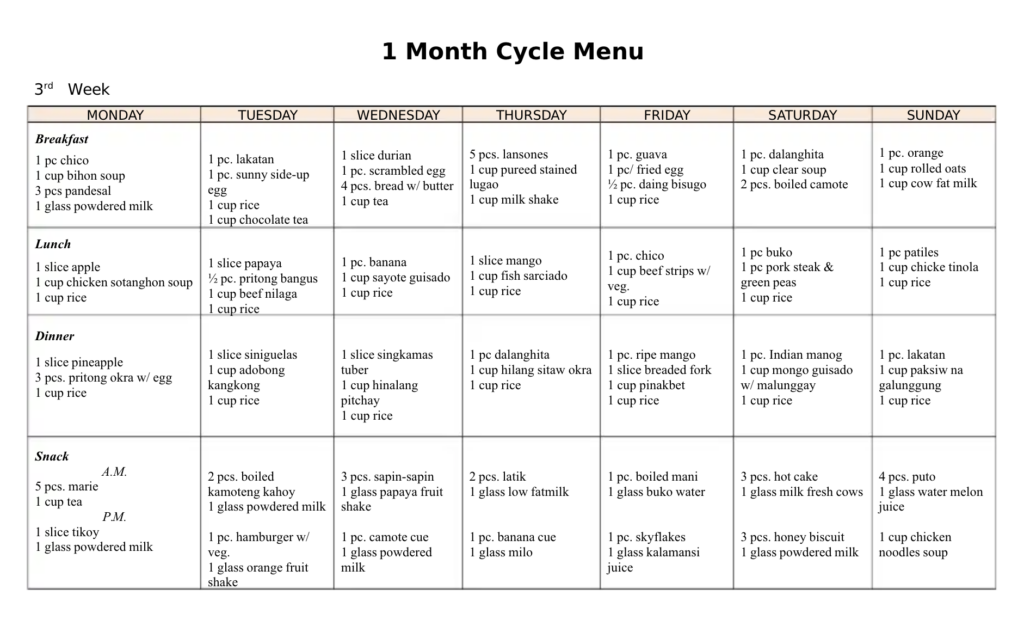
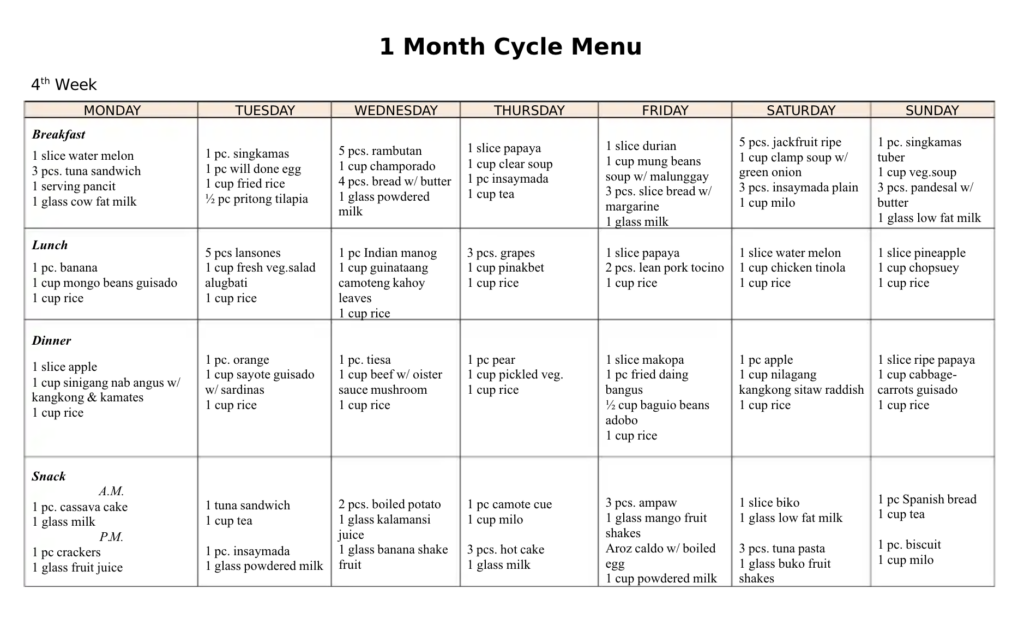
Designing a Cycle Menu
Here are some steps to follow when designing a cycle menu:
Determine the time frame: Decide on the duration of the cycle menu. Will it be a weekly, bi-weekly, or monthly menu?
Identify the target audience: Consider who the menu is designed for. Are there specific dietary requirements to cater for, such as allergies, intolerances, or religious restrictions? Are there age-related considerations, such as providing suitable meals for children or seniors?
Determine the budget: Calculate the budget for the menu, which will help in selecting the right ingredients and dishes.
Plan the meals: Choose a variety of dishes that meet the dietary requirements of the target audience, while ensuring that the menu remains interesting and varied. Consider factors such as availability of ingredients, food safety and storage, and seasonal variations.
Balance the menu: Ensure that the menu is well-balanced, with an appropriate mix of carbohydrates, proteins, and fats. Include a variety of fruits and vegetables to provide essential vitamins and minerals.
There are many factors to consider in order to create a well-balanced Cycle Menu, including:
Dietary requirements: Be sure to accommodate any dietary restrictions or preferences. This can include providing vegetarian or gluten-free options, or avoiding certain allergens.
Availability of ingredients: Consider the availability of ingredients, which may vary depending on seasonality and geographic location. Choose ingredients that are fresh and in season, which can help reduce costs and ensure quality.
Food safety and storage: Ensure that the meals are prepared and stored safely, adhering to food safety guidelines. This may involve refrigerating or freezing certain items, or preparing meals in advance to minimize risks.
Seasonal variations: Consider seasonal variations when designing the menu. For example, in the summer, lighter dishes and salads may be more appropriate, while in the winter, hearty stews and soups may be more suitable.
Offer a variety of food groups: Ensure that the menu includes a variety of food groups, such as fruits, vegetables, grains, and proteins.
Include a range of flavors and textures: Vary the flavors and textures of dishes to keep the menu interesting and appealing.
Choose healthier cooking methods: Opt for cooking methods that are healthier, such as grilling, baking, or steaming, rather than frying.
Pay attention to portion sizes: Ensure that portion sizes are appropriate, particularly for dishes that may be high in calories.
Get feedback: Gather feedback from customers or diners to understand their preferences and make adjustments to the menu accordingly.
Table d’hote menu (also called prix fixe menu) is a menu where a set of complete meals are served at a fixed menu price. Unlike the cycle menu, table d’hote menu does not rotate or change, and customers do not have a choice of items. Table d’hote menu is typically used for special occasions or events such as banquets or weddings.
A la carte menu is a menu where items are priced individually, and customers have the freedom to order what they like. In contrast, cycle menu has a fixed set of dishes that rotate over a specific period. A la carte menu is typically used in high-end restaurants where customers are looking for personalized dining experiences.
Du jour menu is a menu where dishes are prepared and served on a particular day. In contrast, cycle menu has a fixed set of dishes that rotate over a specific period. Du jour menu is typically used in restaurants that want to showcase their chef’s specials or feature dishes that are seasonal or limited.
A static menu is a menu that remains unchanged for an extended period. In contrast, cycle menu has a fixed set of dishes that rotate over a specific period. Static menu is typically used in fast-food chains or restaurants that serve a specific type of cuisine.
Seasonal menu is a menu that changes with the seasons, typically every three months. In contrast, cycle menu has a fixed set of dishes that rotate over a specific period. Seasonal menu is typically used in restaurants that want to showcase fresh produce or ingredients that are in-season.
An ethnic menu is a menu that features dishes from a specific culture or cuisine. In contrast, cycle menu has a fixed set of dishes that rotate over a specific period. Ethnic menu is typically used in restaurants that want to showcase their chef’s expertise in a specific cuisine or culture.
A tasting menu is a set menu that features a predetermined sequence of small dishes or courses, each highlighting different flavors, textures, and cooking techniques. The goal of a tasting menu is to provide a curated culinary experience that showcases the chef’s skills and creativity. Customers generally do not have a choice in what dishes they receive.
As technology continues to evolve, many restaurants are opting to use a digital cycle menu to streamline their operations and improve the customer experience. A digital menu is a modern solution that eliminates the need for paper menus and offers a more efficient and engaging way for customers to order food.
Digital menu for restaurants come in various forms, such as menu displays on tablets or TV screens, mobile apps, or even QR code menus. QR code menus are becoming increasingly popular in the post-pandemic world as they offer contactless ordering and payment options for customers.
Using a digital menu has several benefits. First and foremost, it saves time and resources. Restaurants can easily update their menus and offer daily specials or limited-time offers without having to print new menus. They can also make real-time adjustments to the menu based on inventory availability and customer feedback.
Furthermore, a digital cycle menu can enhance the customer experience by providing interactive features such as food images, nutritional information, and customer reviews. This helps customers make informed choices and enhances their engagement with the restaurant. It also enable restaurants to know valuable data on customer ordering habits and preferences.
When setting up your restaurant, it’s crucial to explore ways to attract more customers to your restaurants. One effective way to do this is by having a dedicated website where your customers can learn everything about your restaurant anytime, anywhere.
Menubly Website Builder lets you create a mini website with a built-in digital menu which centralizes all important information about your restaurant into one accessible link. It makes it easy for your customers to interact with your restaurant: they can view your menu, find your location, book a table, place delivery orders… all in one place.
By adding your mini website link in your Instagram bio and other social media profiles, or sharing it directly with customers, you make it easy for them to discover and engage with your restaurant through a single, convenient link. This streamlined approach not only enhances customer experience but also boosts your online presence and attract more customers.
Best of all? You can set up your Menubly website for Free in just under 5 minutes and tailor it to match your restaurant’s style.
Ready to boost your restaurant’s online presence? Click here to create your free website with Menubly!
A cycle menu is a useful tool for those who need to plan meals on a regular basis, such as schools, hospitals, as well as restaurants. By following the tips and factors discussed in this blog, we hope you can begin designing and implementing cycle menus in your own settings to improve meal planning and provide healthier and more enjoyable meals for your customers.
Turn your paper menu into an interactive online menu that your customers can browse and order from anywhere.